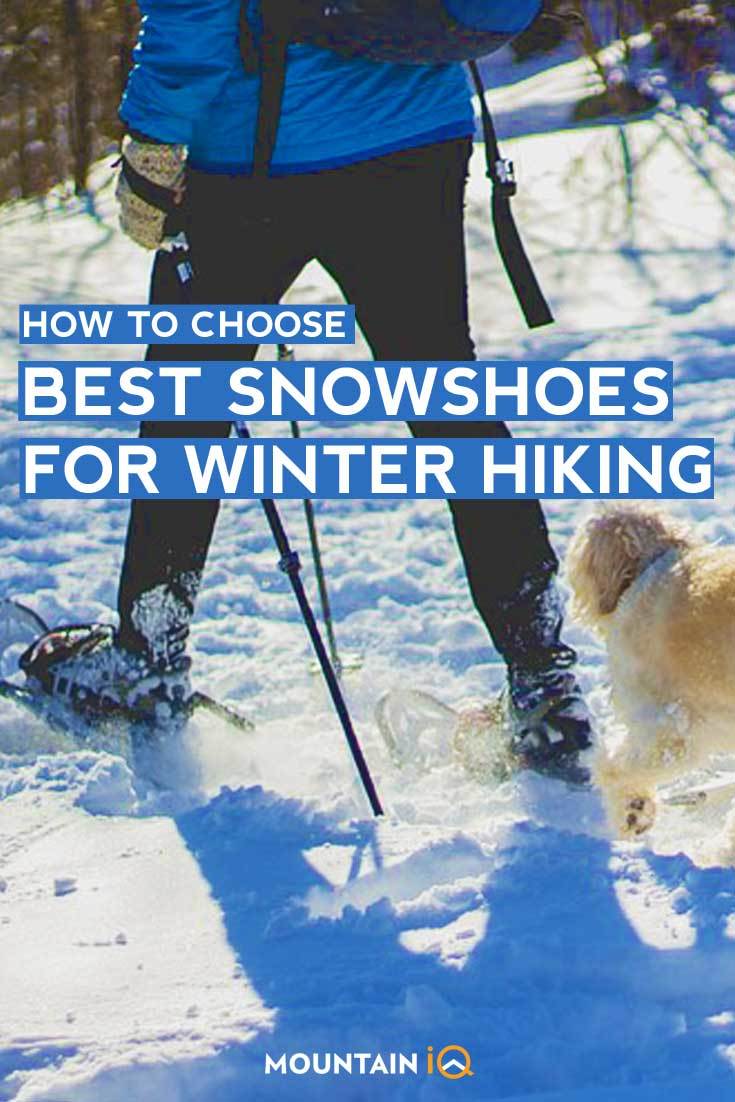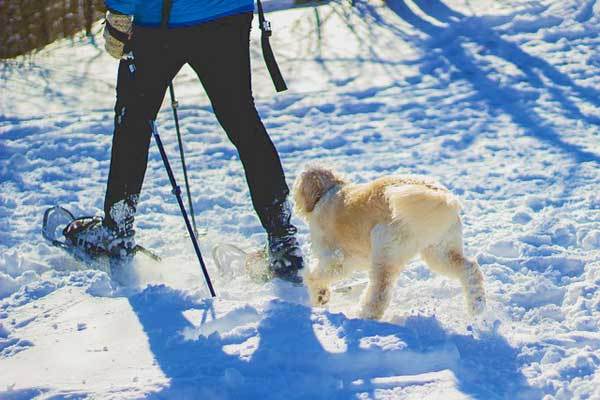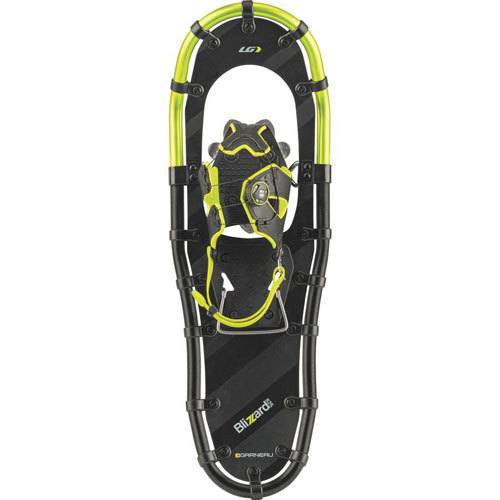The Tubbs Wilderness snowshoes are perfect for beginner recreational snowshoers starting to build up their confidence and experience. They have cobra toe crampons that provide great traction and stability on flat or rolling terrain.
For the more experienced trekkers, you can't go wrong with the MSR Lightning Ascent. These snowshoes are excellent for backcountry trekking in mountainous terrain with durable steel DTX crampons that give you serious bite on alpine steeps.
Best Snowshoes (Top Picks)
Best Overall
Best Beginner
Best On-Trail
This article contains affiliate links. If you buy something through the links on this page, we might get a small commission. It will not affect your price but helps keep our site alive!
Snowshoes for Hiking
Here are my favourite snowshoes:
- MSR Lightning Ascent - Best Overall
- Tubbs Wilderness - Best Beginner
- Louis Garneau Blizzard III
- MSR Evo Trail - Best On-Trail
Read our complete buyers guide for snowshoes.
Best Snow Shoes
1. MSR Lightning Ascent
If you like to travel light and fast through the mountains, then the MSR Lightning Ascent might be for you.
Built specifically for high octane winter activities, the Lightning Ascent are built with MSR’s proprietary 360° Traction frames that provide the utmost in security and stability, especially when on steep traverses.
The Lightning Ascent also come with MSR’s Dual-component PosiLock AT bindings (see video), which create a secure attachment point between you and your snowshoes while the durable decking can handle anyhting you throw at it.
Plus, if you venture frequently into really deep snow, you can snap on the Lightning Ascent’s Modular Flotation tails for an extra 13cm (5in) of float.
Check Prices
Main Features
What we like
What we dislike
Key Takeway
Known for creating some of the world’s best snowshoes, MSR Lightning Ascent takes home our coveted award as the Best Overall because it combines a rugged design with impressive functionality and durability. You might pay a bit more for these snowshoes than you would for other pairs, but in the end, it’s worth it!
2. Tubbs Wilderness
Combining the newest technology with maximum comfort, the Tubbs Wilderness is a tubular aluminum frame snowshoe designed for efficiency and ease of use.
Made with Tubbs’ proprietary 180 Pro binding, the Wilderness quickly adjusts to fits snugly around the foot to add warmth and support without creating annoying pressure-points.
Plus, the Wilderness features a rotation limiter, which allows your foot to rotate within the snowshoe, which allows snow to sluff off the back of the decking while simultaneously preventing over-rotation and shin bang.
If that wasn’t good enough, the Wilderness’ crampon is made from carbon steel to provide superior traction in variable snow conditions, with adding weight.
Check Prices
Main Features
What we like
What we dislike
Key Takeaway
The Tubbs Wilderness is an ideal beginner-friendly snowshoe thanks to its easy on-off design. It was built for comfort, which is perfect for a newer snowshoer that’s just starting to get their feet under them on the snow.
3. Louis Garneau Blizzard III
The Louis Garneau Blizzard III is a heavy-duty snowshoe that can handle heavy loads.
The snowshoes’ Lightect decking is both durable and flexible down to the frigid temperature of -40°F/C, so you can be confident in your gear.
Moreover, the Blizzard II features a Single Boa Closure system for on-the-fly adjustments, which means you won’t have to waist precious moments fiddling with your bindings during your hike.
Where the Blizzard II really shines, however, is in its traction system. With a V-Rail heel crampon, the Blizzard II can provide ample traction on the uphills, downhills, and traverses.
The crampons are made from a lightweight, yet durable high-carbon steel, so they perform well on a variety of terrain and snow conditions.
Main Features
What we like
What we dislike
Key Takeaway
The Louis Garneau Blizzard III is a heavy-duty snowshoe for heavy-duty loads. They’re built to last with quality materials, but this does make them some of the heftiest snowshoes in our review. Thus, they’re best used when maximum load capacity is the priority, such as on long winter backpacking trips.
4. MSR Evo Trail
Simple, light, yet incredibly versatile, the Evo Trail is the snowshoe for no-nonsense hikers who just want to get out into the mountains.
Perfect for the weekend warrior and every-day adventurer, alike, the Evo Trail is built from a plastic UniBody decking with steel traction rails and break bars molded in for the utmost in traction.
MSR’s proprietary DuoFit binding system makes for a simple, freeze-proof on-and-off, even while wearing thick winter gloves.
Plus, if you head out into deep snow, you can clip on MSR’s Modular floatation tails for on-demand float in the powdery stuff. What could be better?
Check Prices
Main Features
What we like
What we dislike
Key Takeaway
The MSR Evo Trail is a great snowshoe for on-trail use. It’s best used as a snowshoe for day hikes or short backpacking trips as it doesn’t have the load capacity to support heavy backpacks.
Snowshoes Buyer’s Guide
Snowshoes are surprisingly complex pieces of gear. There are many different schools of thought as what makes a good snowshoe and there are many different design philosophies that guide the manufacturing of modern snowshoes.
Wading through all of the information that manufacturers provide to consumers can be tricky to do, so we’ve compiled a list of the most important features you should know about before you pick our your next pair of snowshoes.
Here are the top things you should keep in mind when shopping for snowshoes:
Snowshoe Type
While many people think that snowshoes are one-size fits all for any person and any situation, there are actually many different types of snowshoes available, depending on your needs. Generally speaking, snowshoes are differentiated by use, so before you buy a pair of snowshoes, you first need to know what you plan to use them for.
There are three main types of snowshoes: recreational, backcountry, and racing. Recreational snowshoes are best used on flat or rolling terrain and they are great for beginner to intermediate snowshoers who are starting to build up their confidence and experience.
These snowshoes usually feature a wide and long frame with semi-aggressive crampons for deep snow. However, you can often find smaller and narrower recreational snowshoes that are best used on maintained and packed-down trails.
Anyone looking for recreational snowshoes should focus on comfort and ease of use as they usually won’t be venturing out on excessively challenging terrain.
Backcountry snowshoes, on the other hand, should be ready to take on mountainous terrain that is unmaintained.
On these trails, there may be deep snow or icy sections, so backcountry snowshoes need to feature wide frames and aggressive crampons. Backcountry snowshoes must also be durable since we often need to rely on them to be able to move in deep snow.
Racing snowshoes are designed for people who like to trail run in the winter but live somewhere with deep snow. These snowshoes tend to be lightweight, short, and narrow because most snowshoe running takes place on packed-down trails. However, racing snowshoes usually feature semi-aggressive crampons for better traction as you run.
Snowshoe Components
Snowshoes feature a number of different components, each of which is important for the gear’s overall functionality. At first glance, it may be difficult to discern the different parts of a snowshoe and their importance, so we’ve broken it all down here for you:
Frame
Back in the day, snowshoes were made of heavy wood and formed into a large teardrop shape. While they did provide a lot of floatation, such frames were heavy and unwieldy when trying to move quickly over difficult terrain.
Modern snowshoes feature frames made from aluminum, steel, or carbon fiber. While some snowshoes have a tubular metal frame, many newer models are made wholly of composite plastic, which offers better traction in icy terrain.
Decking
The decking of a snowshoe is the part that provides floatation. For snowshoes with tubular frames, the decking is often made from some sort of synthetic leather or synthetic rubber that’s stretched over the top of the metal to provide more surface area, which prevents you from sinking.
When it comes to snowshoes made from plastic, the plastic actually serves as both the frame and the decking. If you compare plastic decking to the more traditional options, plastic is usually more durable and versatile due to its rigidity.
Crampon and Traction
If you spend most of your time on flat or rolling groomed trails, you may not be terribly concerned with crampons and traction in your snowshoes. However, if you like to venture off trail or into the mountains, then you’ll certainly want a pair of snowshoes with crampons that can provide traction on steep terrain.
Usually, the crampons of a snowshoe are integrated into the underside of a binding. On snowshoes with hinged bindings, the binding swivels to allow your foot to move independently of the snowshoes’ decking, for a more natural stride. On other snowshoes, with fixed bindings, allow for minimal movement of the foot in relation to the snowshoe as you walk.
Some crampons are more aggressive than others, so if traction is important to you, this is a key thing to look for when buying snowshoes.
Binding
Different snowshoe manufacturers use a variety of different systems for attaching the snowshoe to your foot. The part of the snowshoe that attaches to your foot is known as the binding. As you can imagine, having a high-quality binding is important so that your snowshoe doesn’t fall off as you walk.
Although everyone agrees that bindings are important on snowshoes, there is no consensus about which binding system is best.
Some people strongly prefer the durability rubber straps of the MSR snowshoe line while others enjoy the ease-of-use of some other systems that require you to simply pull on a single nylon strap to tighten the binding around your foot.
Ultimately, this seems to be a matter of personal preference, but it’s important to find a binding that you enjoy using.
Sizing
While you’ll see many “snowshoe sizing guides” out on the internet, the fact of the matter is that snowshoe sizing is not the type of thing one can make blanket statements about.
This is because of the sizing of a snowshoe relies on a large number of different factors, including the size and weight of the snowshoer, the terrain involved, the snow conditions, and the amount of weight you’ll be carrying.
Thus, instead of giving you a one-size-fits-all answer, we’ll give you the information you need to determine your own snowshoe size.
The first thing you should think about when sizing snowshoes is the terrain you’ll be on. If you’re planning on hiking in the backcountry or on steep slopes, you’ll want more compact snowshoes with hinged bindings and good crampons. Head off trail, on the other hand, and you might want a bit more floatation to deal with deep snowpacks.
When it comes to the size and weight of a person, you’ll want to look at the snowshoes’ “weight load” rating. This rating should include your weight and the weight of the gear you’ll carry.
Since heavier loads are best served by larger snowshoes, you'll want to check out the range of weight loads that a specific model can handle before you drop some serious dough on a new pair of snowshoes.
Men's vs Women's Models
You’ll often see snowshoes labeled as “men’s,” “women’s,” or “unisex” but does this matter? What does this label even mean?
It turns out that (surprise!) the difference between a “men’s” and “women’s” snowshoe is usually size and color. Women’s snowshoes tend to come in smaller sizes, both in terms of the decking and the size of a shoe that the binding can accommodate.
Often, women’s snowshoes are narrower to help people with smaller bodies achieve a more natural size. Additionally, women’s snowshoes also come in more traditionally “feminine” colors, such as pink and purple.
However, unless you’re a particularly petite person, you’ll probably be able to comfortably wear men’s or unisex models.
Smaller people of any gender usually benefit from the smaller proportions of a “women’s” snowshoe while larger people of any gender often prefer the increased floatation of a “men’s” snowshoe, but really it all comes down to personal preference.
Continue browsing
See more equipment reviews and our detailed outdoor footwear guide. Or check out these reviews:






